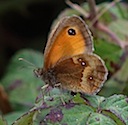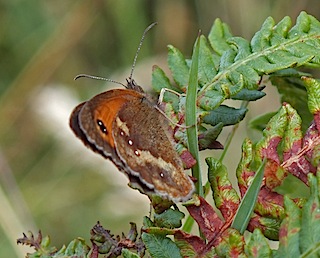 Late July and early August is the peak time for the chocolate and orange Gatekeeper butterfly. Look out for them round hedgerows and scrubby areas.
Late July and early August is the peak time for the chocolate and orange Gatekeeper butterfly. Look out for them round hedgerows and scrubby areas.
Photo: Amanda Scott
Scientific name: Pyronia tithonus
Other common names: Hedge Brown
Cornish name: ‘Tikki-dui’ is the general word for butterfly
What to look for:
- Colouring: Orange and brown pattern on both fore- and hindwings, with white spots on the underside of the hindwing. The dark eye on the forewing contains two white spots. It’s fairly easy to tell males from females as the former have a dark band across each forewing, though this fades with age.
- Size: Wingspan: 37 to 43 mm (male), 42 to 48 mm (female).
- Where: Common in the southern half of the UK, and now spreading northward in range. This is a butterfly of hedgerows and open woodland, wherever shrubs border scrubby grassland.
- When: Adults are on the wing from mid-July to the end of August.
- Similar species: Meadow Brown, which is duller in colouring and larger. Faded Gatekeepers could be confused with Meadow Browns. Look for the two white spots in the eye on the Gatekeeper’s forewing, compared to the single spot of the Meadow Brown.
 If you spot one Gatekeeper, a delightful orange-and-chocolate butterfly of hedgerows and scrub, then you’ll almost definitely spot several. This is a colonial species, and individuals don’t wander far. Look out for it basking with open wings on sunny days.
If you spot one Gatekeeper, a delightful orange-and-chocolate butterfly of hedgerows and scrub, then you’ll almost definitely spot several. This is a colonial species, and individuals don’t wander far. Look out for it basking with open wings on sunny days.
The larval foodplants are a number of different grasses, especially bents, fescues and meadow-grasses. The caterpillars, which vary in colour from grey to green to yellowish-brown, are covered with delicate hairs. They overwinter beneath tussocks of grass, and then pupate the following June, hidden carefully beneath a leaf.
Did you know…?
…The range of the Gatekeeper is limited by climate more than other factors – it likes warmer climes. This is probably why it is now starting to spread northwards, given the warming climate.
…Many Gatekeeper colonies are fairly small but, if there is enough good habitat, a single colony may include thousands of butterflies.
More information and references:
Wacher, J., Worth, J. and Spalding, A., 2003. A Cornwall Butterfly Atlas. Pisces Publications, Newbury, Berkshire.
Newland, D., Still, R., Swash, A. and Tomlinson, D., 2002. Britain’s Butterflies. A Field Guide to the Butterflies of Britain and Ireland (third edition). Princeton University Press, Oxfordshire.
Published: July 2015
Author: Amanda Scott
Photos: Amanda Scott
